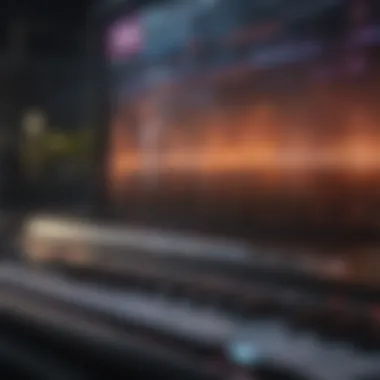Analyzing the Landscape of YouTube Trending Music Today


Intro
The sphere of music on YouTube is constantly evolving, reflecting changes in consumer preferences, technological advancements, and cultural shifts. This article provides a nuanced exploration of trending music on YouTube, dissecting the factors that contribute to the popularity and rapid dissemination of songs. From the persistent rise of algorithmic recommendations to the impactful role of social media, we will analyze the elements that shape the contemporary music landscape.
Understanding the dynamics of trending music requires a comprehensive investigation into specific artists and their respective works. This includes a detailed consideration of their backgrounds, major influences, and how these factors inform their musical output. Throughout this article, we will delve into song analysis, including thematic and lyrical elements as well as the underlying instrumentation and composition styles that resonate with today’s listeners.
Artist Profile
Biography and Background
To grasp the ongoing trends in music, one must first explore the artists behind the hits. Each artist emerges from a unique socio-cultural backdrop that influences their sound and vision. Knowledge about their journey—where they come from, their early life experiences, and the challenges they faced—provides insight into their music. For instance, examining the biography of an artist like Bad Bunny sheds light on how Latino culture and experiences inform his musical style and lyrical themes.
Major Influences and Inspirations
Artists often draw inspiration from a myriad of sources. This section will investigate the influences that shape contemporary musicians. Many tap into genres across the spectrum—from hip-hop to pop, country to electronic. Recognizable figures such as Prince, Madonna, and even more recent influencers, like Billie Eilish, serve as potent examples of how diverse influences coalesce to craft unique sounds. The power of collaboration also plays a significant role in this creative process, illustrating how partnerships can lead to innovative trajectories in music.
Song Analysis
Theme and Lyrics Breakdown
A song’s theme often encapsulates key societal narratives, personal experiences, or cultural phenomena. Analyzing lyrics provides a window into artists’ thoughts and emotions. For example, examining the lyrics of a popular song like "Drivers License" by Olivia Rodrigo reveals deep emotional struggles that resonate with many. By dissecting such themes, we can understand the psychological undercurrents that drive listeners to connect with particular songs and artists.
Instrumentation and Composition
Music composition and the elements of instrumentation also are crucial. Recent trends often feature a blend of synthetic sounds and traditional instruments, leading to a distinct sonic identity. Artists like The Weeknd exemplify this, blending R&B with pop influences and electronic components. Understanding these compositional strategies helps in recognizing why certain tracks perform better on streaming platforms like YouTube.
"The digital age has democratized music, allowing diverse voices to emerge and reshape cultural narratives."
In the sections that follow, we will further explore the intricacies of trending music on YouTube, providing valuable insights into how these dynamic and multifaceted elements contribute to the current musical landscape.
Prolusion to YouTube's Music Trends
The rise of YouTube as a dominant platform for music consumption has shifted how audiences connect with their favorite artists and discover new sounds. This section delves into the crucial role YouTube plays in the landscape of contemporary music trends. As a vast repository of content, YouTube not only provides access to a diverse range of music genres but also serves as a powerful tool for promotion and discovery.
The Importance of YouTube in Music Consumption
YouTube stands as a significant player in the music industry. With billions of users, it reaches a global audience. The platform allows users to easily access both mainstream and niche music. Furthermore, it offers an avenue for aspiring musicians to showcase their work. The algorithm pushes content based on user preferences and behavior, making personalized recommendations possible. This has led to an increase in non-traditional music discovery.
In addition to acting as a listening platform, YouTube plays a vital role in marketing. Initiatives such as music videos, live performances, and collaborations contribute to an artist's visibility. For many, YouTube is their first exposure to new releases. Data indicates that many listeners rely on the platform as their primary means of discovering new music.
Defining Trending Music
Understanding what qualifies as trending music requires more than just looking at numbers. "Trending music" refers to songs that are currently receiving considerable attention. This can be measured through various metrics such as views, likes, and shares. However, trends are often fleeting and influenced by numerous factors.
Factors influencing trending status may include historical significance, timing around cultural events, and cross-promotions on social media. Such dynamics ensure that what is popular shifts frequently. Being aware of these elements provides deeper insights into what connects audiences with particular music.
"Music that trends reflects not only artistic merit but also cultural resonance within a given moment."
By analyzing what is currently trending on YouTube, we can better understand the broader implications of music consumption in a digital format, shaping the future of the industry.
The Mechanism Behind YouTube's Trending Algorithm


Understanding the trending algorithm on YouTube is crucial for anyone looking to explore the music landscape on the platform. This algorithm determines which songs gain visibility and popularity, influencing culture and music consumption significantly. YouTube's unique algorithm works by collating a range of factors to ascertain trending status, creating a dynamic environment that reflects viewer behavior, content efficacy, and external social influences.
How YouTube Tracks Trends
YouTube uses a combination of data analytics and user engagement metrics to track which music videos are trending at any given moment. The platform continuously monitors user interactions, such as views, likes, and shares. This data is aggregated to determine what resonates with the audience and often reflects broader cultural movements. By analyzing patterns in user behavior, YouTube can identify and promote content that captures viewers’ interests.
Factors Influencing Trending Status
Various elements play a significant role in establishing what ranks as trending. Each factor contributes differently but holds considerable weight in gaining a song its trending status.
View Count
The view count is a primary indicator of a video's popularity. When a song amasses a high number of views within a short time, it signals to the algorithm that the content is gaining traction. This characteristic makes view count a beneficial aspect of trending status; it reflects broad audience interest and engagement. However, the unique feature of view count is that it can be easily manipulated through false engagement or bots. This manipulation can lead to misleading trends that do not accurately reflect genuine audience reception.
Engagement Metrics
Engagement metrics encompass a range of interactions, including likes, shares, comments, and time spent watching. These metrics provide deeper insights into how well the audience connects with a song. The engagement level is a beneficial aspect for determining a video's quality rather than just its popularity. A song with fewer views but high engagement might indicate a strong fan base, which can create long-term interest. However, engagement metrics can sometimes be less indicative of a song’s real-world success. A high number of likes does not necessarily translate to real-world downloads or concerts.
User Demographics
User demographics include age, location, and viewing habits of the audience. This aspect is crucial because it helps identify which groups are engaging with specific music genres. By understanding user demographics, the algorithm can cater to varied listener preferences, making it a powerful tool for artists aiming at targeted audiences. The downside is that demographic data may not always be available for every viewer, which can skew the understanding of who is truly engaging with a piece of music.
"YouTube's algorithm is continuously evolving, making it essential for artists to understand the changing landscape of viewer engagement and preferences."
In unveiling these elements, the article will provide a comprehensive view of how YouTube's trending algorithm shapes the music landscape today.
Current Trends in Music Genres
The landscape of music genres on YouTube is fluid, reflecting not only artistic innovation but also shifting cultural dynamics. Understanding current trends allows us to grasp how new sounds emerge and gain traction. This section highlights the importance of being aware of these trends, as they help artists and fans alike navigate an ever-changing musical environment. The insights gleaned here are useful for aspiring musicians looking to find their niche, as well as music enthusiasts wanting to stay informed about new developments in the industry.
Emerging Genres on YouTube
YouTube has become a breeding ground for emerging genres. Genres like lo-fi hip-hop, bedroom pop, and hyperpop have gained significant popularity in the past few years. These styles often blur traditional genre lines, combining various influences to create something entirely new.
Lofi hip-hop, for instance, thrives on its relaxing beats, often paired with anime visuals, creating a unique listening atmosphere. On the other hand, bedroom pop reflects a DIY approach to production, often utilizing simple equipment and home studios. This accessibility lowers barriers for new artists and allows for a diverse range of voices.
The rapid growth of these genres emphasizes the importance of online platforms. Artists can upload their work independently, reaching a global audience instantly. Consequently, listeners can discover sounds they may not encounter in mainstream media. This democratization of music is reshaping how we define what is popular.
"YouTube has transformed music discovery, allowing lesser-known genres to flourish alongside big names, thus shaping new musical landscapes."
The Influence of Genre Blending
Genre blending is a significant aspect of the current music scene on YouTube. This practice allows various musical elements to merge, creating innovative sounds that resonate with a wide array of audiences. For instance, artists are increasingly mixing electronic music with traditional genres like country or rock. This fusion not only revitalizes established sounds but also appeals to fans across different musical backgrounds.
Some notable examples include Lil Nas X’s Old Town Road, which combines country and rap, resulting in a cross-genre hit that topped the charts for weeks. Another compelling case is Halsey, who infuses elements from pop, rock, and indie into her music, attracting a diverse fan base.
The impact of genre blending on YouTube cannot be overstated. It breaks down strict genre classifications, allowing for more creative expression. This, in turn, influences trends on the platform. Audiences are more open to diverse sounds and styles. This openness encourages artists to experiment without fear of alienating listeners. Overall, genre blending is not just a trend but a significant evolution in how music is produced, consumed, and understood.
Artist Influence on Trends
The influence of artists in shaping music trends on YouTube is substantial and multifaceted. Artists carry the weight of their popularity and brand, which significantly affects what becomes trending on the platform. Their ability to draw in audiences plays a key role in determining a song’s reach and relevance within the music community. In this section, we will explore two critical aspects that demonstrate how artists influence trends: the dominance of popular artists and the effects of collaborations.


Popular Artists Dominating the Charts
Certain artists consistently dominate the YouTube charts, and their presence is a major driver of what is considered trending music. These artists can sway public opinion and affect the consumption of music through their established fan bases and mass appeal. For instance, artists like Bad Bunny, Taylor Swift, and Drake frequently appear in trending lists due to their large following and ability to create engaging content that resonates with diverse audiences.
This influence can be attributed to several factors:
- Strong Fan Engagement: Popular artists often maintain strong communication with their followers via social media platforms, boosting their visibility and engagement.
- High-Quality Production: Top artists typically invest significantly in music production, ensuring their releases are of high auditory and visual quality, which attracts more viewers.
- Strategic Marketing: Through partnerships with brands and incorporation of current themes, artists can align their releases with cultural movements, ensuring they stay relevant.
The expectation is that this pattern will continue as more artists learn to navigate the digital landscape.
The Role of Collaborations
Collaboration among artists has become an essential strategy in the modern music landscape. When two or more well-known artists collaborate on a song, they blend their fanbases, which often leads to increased visibility and traction. For example, the collaboration between Lil Nas X and Billy Ray Cyrus for "Old Town Road" became a cultural phenomenon, showcasing the tremendous potential of combined talent to trend.
Several elements contribute to the efficacy of collaborations in influencing music trends:
- Audience Expansion: Collaborations introduce artists to each other's audiences, creating cross-promotion opportunities that can significantly boost view counts and streaming numbers.
- Diverse Soundscapes: Collaborating artists often merge different genres and styles, appealing to a wider audience and keeping the content fresh.
- Engaging Storytelling: Frequently, collaborative efforts result in songs that tell powerful stories or address contemporary issues, which can resonate more deeply with listeners.
Collaboration, when done right, enables both established and emerging artists to push the envelope of creativity in music.
In summary, the influence of artists on music trends on YouTube is undeniable. Popular artists shape trends through their visibility and the content they release. Simultaneously, collaborations provide an innovative way to reach new audiences and enhance the soundscape. This dynamic interplay is not only a hallmark of successful contemporary music but also a significant force in shaping the future of the music industry.
The Impact of Social Media on Music Trends
Social media has become a powerful force in shaping music trends today. Platforms like Instagram, TikTok, and Twitter facilitate immediate connections between artists and their audiences. The rise of social media has given musicians a direct path to promote their work without relying solely on traditional media avenues. This connection allows artists to foster a community that supports their music and contributes to its popularity.
The cultural impact of social media on music is profound. Artists are now able to test new ideas and sounds with their followers, receiving instant feedback that can guide their creative process. They can share snippets of upcoming songs or behind-the-scenes looks that engage fans and build anticipation. As a result, social media does not merely promote music; it actively shapes the artistry behind it.
Additionally, social media amplifies reach. A single post or video can cross geographic barriers, allowing music from diverse cultures to emerge in various markets. This integration promotes a melting pot of sounds and styles that might not have gained traction in a more isolated music landscape.
"Social media is now like a digital radio for every artist, creating opportunities that did not exist a decade ago."
Cross-Promotion on Social Platforms
Cross-promotion on social platforms is an essential strategy for enhancing visibility in a crowded music environment. This technique involves artists collaborating with influencers or fellow musicians to share content across multiple channels. For instance, a new song can be promoted by a popular TikTok creator who dances to the track, generating buzz through their followers.
Such practices cultivate a snowball effect. The more platforms an artist is featured on, the greater their chances of going viral. Effective cross-promotion also leads to increased engagement metrics. Videos shared across TikTok, Instagram Reels, or YouTube Shorts can exponentially increase a song's exposure.
Musical artists can now utilize features like IGTV for longer formats or stories for quick updates and teasers. Collaboration with popular figures on platforms can introduce their music to different demographics, further expanding their audience. This method enables smaller artists to gain considerable traction and attain trending status on YouTube.
Viral Moments and Their Role in Trending Music
Viral moments play a crucial role in determining what music trends on YouTube. These moments can arise unexpectedly, often driven by meme culture or significant events in pop culture. A song might gain traction because a viral TikTok dance incorporates it, leading to a sudden spike in views and downloads.
Such moments often create a sense of urgency among listeners. When a track goes viral, it can lead to an increased search volume and engagement on YouTube. In many instances, songs that initially may not seem commercially viable cultivate popularity through viral moments, ultimately resulting in chart success.
Moreover, the dynamics of viral trends can lead to an unpredictability that keeps the music landscape vibrant. Artists may find themselves in the spotlight due to a simple, shareable moment rather than traditional marketing strategies.
In summary, social media is revolutionizing how music is consumed and shared. It not only drives trends but also defines modern artist-audience interactions. The relationships nurtured on these platforms persist and evolve in ways that traditional media cannot emulate.
The Globalization of Music Through YouTube


YouTube plays a significant role in the globalization of music. Its platform enables artists from all over the world to share their music with a broad audience. This accessibility democratizes music, giving a voice to both established and emerging artists. In this environment, geographical boundaries become less relevant as diverse music styles reach listeners far from their places of origin.
This globalization brings many benefits. First, it provides international artists a chance to gain exposure and connect with fans outside their local markets. For example, artists from Latin America often find a substantial audience in Europe and North America, thanks to YouTube. Additionally, listeners gain access to an array of musical styles, enriching their listening experiences. It is important to note that this exchange of sounds influences trends across the globe, allowing music to evolve repeatedly.
However, there are considerations that come with this globalization. Market saturation is one issue; as more artists join, it becomes challenging for individual songs to stand out. Moreover, the different cultural contexts can lead to misunderstandings or the commodification of musical styles. Some critics argue that popular music may lose authenticity due to such influences. Still, the platform manages to foster connections that would be unlikely in a more traditional music industry setting.
International Artists and Local Trends
International artists are frequently chart-toppers on YouTube, illustrating the platform's global reach. These artists capitalize on their unique sounds and styles, attracting local audiences who might not have been exposed to such music otherwise. For example, K-pop artists like BTS and BLACKPINK have amassed large followings in Western countries. This is not merely due to their catchy tunes, but also their polished production values and the universal themes present in their lyrics.
Unsurprisingly, YouTube has become a hub for discovering new music genres pushing local trends into the spotlight. Artists become American, European, or African sensations thanks to collaborations and features spanning various cultures. In this way, local trends are not just maintained but often transformed by global influences.
Fusion of Cultural Influences
The fusion of cultural influences on YouTube reshapes music significantly. Artists from different backgrounds collaborate, blending elements that lead to new genres. This is particularly notable when artists from culturally diverse countries work together, creating sounds that appeal to wide audiences. For instance, Reggaeton, which has roots in Latin American music, has merged with Hip-Hop and R&B, attracting global attention.
The collaboration of diverse cultural influences often results in unexpected and innovative music, which captures the ears of audiences worldwide.
As elements from various genres mix, they often lead to the birth of new subgenres. This trend reflects a more interconnected world, where artists are free to borrow without restrictions. It encourages musicians to explore and express their identities in ways that resonate on an international scale. Ultimately, this fusion enriches the fabric of global music and innovation in storytelling through sound.
Ethical Considerations in Music Trends
The music landscape on YouTube is not just about sound and rhythm; it is intertwined with profound ethical considerations. As the platform evolves, growing awareness of these ethical dimensions becomes essential. Understanding copyright issues and the need for representation and diversity can enhance the music community, ensuring a fair and inclusive environment for artists and audiences alike.
Copyright Issues and Content Creation
Copyright remains a critical discussion point among creators on YouTube. This legal framework ensures that artists maintain rights over their work, which is essential for protecting creative integrity. This is especially vital in a digital era where music can be easily replicated and shared without proper acknowledgment.
Content creation on YouTube must navigate this complex landscape. Artists often face hurdles when they wish to use snippets of songs or visuals that they do not own. Violation of copyright can lead to content being taken down, loss of income, or even legal consequences. Thus, understanding copyright is not just about legality; it is also about fostering creativity within safe boundaries.
Representation and Diversity in Music
Representation in music is imperative for reflected authenticity. YouTube has the power to elevate voices that mainstream media often overlooks. This encourages a broader understanding of different cultures and musical styles. However, the challenge lies in ensuring diverse representation becomes normalized rather than tokenized.
Promoting a variety of artists from different backgrounds enriches the music trends on YouTube. As we notice genres merging and cultural influences blending, it is essential to highlight talents from underrepresented communities. This can enlighten audiences about experiences outside their own, enriching the listening experience.
To quote a recent analysis, "Diverse voices in music not only drive trends but shape cultural dialogues."
Culmination: The Future of Music Trends on YouTube
Understanding the future of music trends on YouTube is crucial in the modern landscape of music consumption. As the platform evolves, so do the ways in which artists connect with audiences. From the rise of algorithm-driven recommendations to the growing influence of social media, each factor plays an essential role in shaping what music becomes popular. The intricate relationships between these elements highlight a shifting paradigm, where trends can be formed and dissipated at remarkable speeds.
Predicting Future Trends
Predicting future trends in music on YouTube relies heavily on data analytics and historical context. Monitoring emerging genres, as well as shifts in user engagement, provides insights into what listeners may embrace next. Artists need to be aware of what resonates with audiences, blending styles and cultural elements to appeal to diverse groups. For example, the fusion of hip-hop and pop has created a surge in artists who can cross-over between genres.
Key indicators for predicting trends may include:
- Data analytics from previous viral content.
- Engagement metrics that showcase listenership patterns.
- Social media discussions relating to new music releases.
Additionally, the interaction between traditional media and online platforms will likely affect future trends. As more artists release singles directly on platforms like YouTube before wider distribution, their approach to marketing will need to be timely and innovative.
The Evolution of the Music Landscape
The music landscape is undergoing continual transformation, driven by advances in technology and user behavior. YouTube was once a simple platform for sharing videos; now, it has become a comprehensive ecosystem for music discovery. Artists no longer rely solely on record labels to promote their music. Instead, they directly engage with fans via YouTube, sharing their stories and artistic processes. This has democratized music consumption fundamentally, allowing lesser-known talents to gain traction alongside established artists.
"The landscape for music promotion has changed profoundly, offering opportunities to all kinds of artists."
Furthermore, the evolution of music genres plays a critical role in this landscape. Each year uncovers new methods of blending sounds and creating fresh experiences for listeners. The demand for novelty in music keeps innovation high. As these trends continue to advance, it is essential for emerging artists and industry professionals to approach future developments with adaptability and foresight.







